November 5, 2007 at 11:24 pm · Filed under Uncategorized
Not long after we arrived in Amador City, I knew we would want to stay two nights. The town is just a tiny blip in a valley, the remnant of a gold strike along historic Route 49 in California. There’s not a lot to do here, but the simplicity and quiet of the little town were hugely appealing to me.

Our Airstream occupies a huge chunk of Rob & Sadie’s driveway next to their Airstream, forcing them to park on the street, but they were very gracious about our request for a second night. With an electric cord from the garage, a connection to their outside water spigot, and absolutely perfect daytime temperatures, we’ve been very comfortable here. They are lucky that Yosemite is calling us, because otherwise we’d be tempted to stay a lot longer.
Just across the street are the remains of the first hard-rock gold mine in California, soon to be re-developed into housing. The developer is considering plans to retain some of the gold mine remnants, since the site is somewhat historic. He drove by our Airstream today and paused to admire it in the driveway. I told him to remember to leave space in the development for Airstream parking, and he said, “No problem!”
Our mail arrived at the little post office one block from the house, two big boxes, two fat Priority Mail envelopes, and a box of ten advance copies of the Winter 2007 Airstream Life. When we get mail, we usually get a lot of it. I sat down in front of the laptop and spent most of the day processing all the business mail that came in. The two big boxes contained a treasure trove of CDs, mostly photographs and past electronic layouts of the magazine that I need to organize and copy. I’ll be buying a new external hard drive soon for this project, and possibly moving my thousands of photos from the Mac’s default program (iPhoto) to something a little more robust.
By the way, copies of the Winter 2007 magazine should be in the mail to subscribers this week (but keep in mind they can take up to three weeks to arrive!) The magazine has a little surprise about it which long-time subscribers will notice immediately. I’ll let you find out for yourselves.
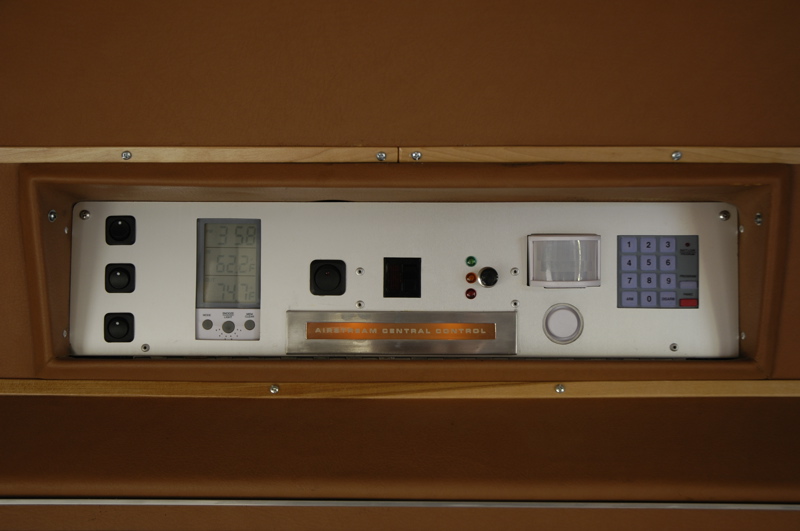
Rob gave us a little tour of his 1973 Airstream Safari, which he has been renovating for some time. We last saw this trailer at the 2006 Rocky Mountain Vintage Airstream Rally in Creede CO. The interior is very cool, with lots of interesting customizations. Among other things, it has solar panels, a retrofitted gray tank, a pure-sine wave inverter that powers every AC outlet in the trailer, a security system, custom cabinets, and custom lighting. It’s still not quite done but very usable and quite unique.
This afternoon Kelli called to say that Rt 140 into Yosemite is closed to vehicles over 28 feet long due to a rock slide. They found out the hard way, and were in the process of figuring out their detour. Fortunately, we will be coming in via Rt 120 (the northern entrance) and shouldn’t be affected.
Tonight and last night we have had dinner with Rob & Sadie in their little house. Like us, they are fans of small architecture. The house was expanded out of a 3-bay garage on a tiny plot of land. Rob and Sadie have managed to create a beautiful townhouse that functions beautifully in hardly any space at all. Like the Airstream, it reflects an appreciation for utility, form, and durability. The house feels very comfortable because it takes into account the needs of human beings first, rather than trying to impress, which is what the best RV’s do also.
November 5, 2007 at 12:47 am · Filed under FAQs, Tips & Ideas
It has been a very pleasant Sunday. Our overnight parking spot on the street in front of photographer Doug Keister‘s house turned out to be very quiet. Doug gave us a quick tour of Chico, and then did a little photo shoot of Emma for possible inclusion in one of his future projects. By 11:30, we were shoving off and moving south on Rt 99 again, toward tonight’s courtesy parking spot in Amador City, CA.
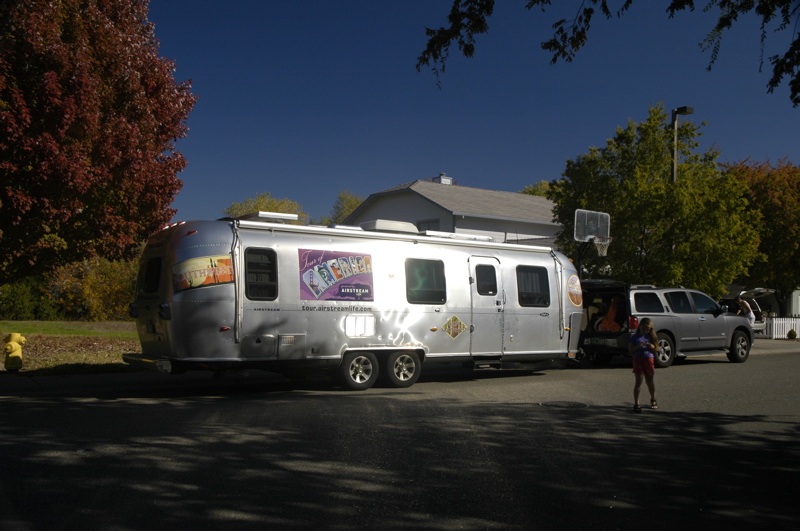
Courtesy parking is one of our favorite modes of “camping.” When you park at someone’s house, you often get the benefit of a fun visit and great insider tips about the local area. Since we’ve been in campgrounds a lot lately, I’ve been looking forward to a few nights of courtesy parking. It makes a nice balance, in addition to saving money.
But campgrounds still constitute the bulk of our nights on the road, so it pays to have a solid understanding of what to look for in a campground. I know from talking to other RV travelers that there is a lot of confusion about this. I’ve rarely talked about the differences between campgrounds, but perhaps it’s time. Campgrounds are not all made equal.
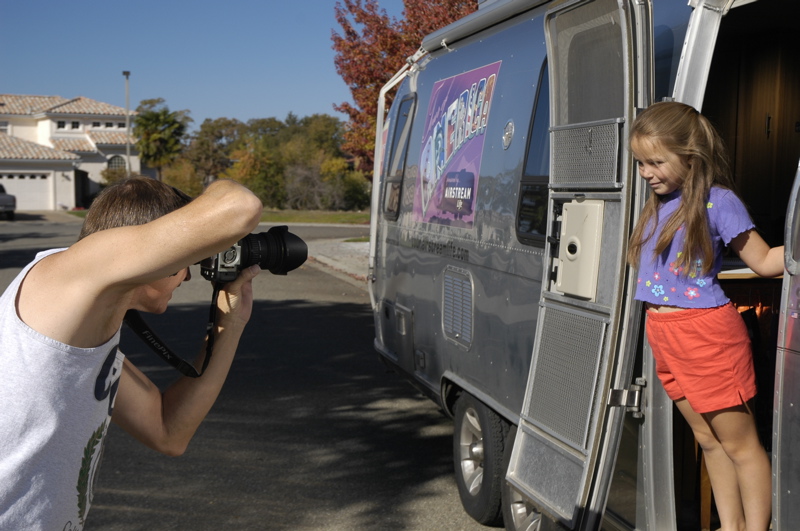
With time, you can develop a sense of what sort of camping experience you’ll get just by looking at the entrance to a campground, or from reading its description in a guide. If we want a scenic, natural, and peaceful experience above all, we tend to avoid places with hundreds of sites, those that are visible from the Interstate, and those with high percentages of permanent residents. Often just the appearance of the entry gate or sign will give a solid clue to the experience that awaits within.
Terms in guidebooks like “big rig friendly,” “laundry, store, and pool,” and “all pull-throughs” are hints that the campground will offer convenience but probably not natural settings. It’s up to you to decide what you want that night. We vacillate between seeking convenience and connectivity (cell phone, Internet), and solitude and natural beauty. In some cases we can find both, but more often a compromise has to be made. My general rule of thumb is that desirability of a spot is inversely proportional to the likelihood of getting online. When we do find a place that offers it all, we stay longer.
There are other clues as well. For example, campgrounds that participate heavily in deep-discount membership programs are generally not in highly desirable locations, but there are exceptions. Most often we find they are at the edge of town or a bit run down. Still, if you’re a member of Passport America, Happy Camper, or other similar programs, the discount often makes up for the minor deficiencies of the campground.
State parks are almost always pleasant but you need to understand each state to know what to expect. In Florida, for example, all state parks with camping have 30-amp electric. In Vermont, none do. Older state parks built during the CCC era (1930s) generally have narrower roads and smaller sites, but nicer settings, so an abundance of CCC-type architecture (stone walls for example) is a clue.
Campgrounds that are predominantly mobile home parks are almost always best avoided. While the sign may say “RV’s welcome”, we’ve never seen one that we’d want to spend money to stay in. However, a lot of RV parks have a small area of fixed or mobile homes off to the side, and those are usually fine.
“55+” is a glaring clue. Since we aren’t over 55 years old, and we travel with a child, we regard “55+” as a sign that the park is filled with stodgy people who have lost their appreciation of children. I appreciate the warning. We’ll go somewhere else. (It’s a shame that these discriminatory “55+” parks are such a plague in Arizona and Florida, however.)
National Forest Service campgrounds, Bureau of Land Management campgrounds, and Corps of Engineers campgrounds can be found in some really spectacular natural areas, and they’re usually cheap. They tend to be in the boondocks. Finding one near where you want to be can be tricky, but if there’s one nearby, they are often pleasantly surprising.
If you’re the sort of person who likes to eat at chain restaurants everywhere you go because you know what to expect, you’ll love big camping chains like KOA. But if you’re the adventuresome type that likes to try the local food wherever you go, you’ll soon learn the subtle cues that lead you to the type of stay you want.
Tonight we are parked at Rob & Sadie’s house in the tiny gold-mining town of Amador City CA. Since we’ll be here two nights, I’ll tell you all about it tomorrow.
November 3, 2007 at 11:59 am · Filed under Uncategorized
One of the best things about traveling by RV is that you can drive to the season you want. Most RV travelers naturally gravitate from north to south in winter, but we have chosen this year to enjoy an extended fall season by traveling to the northwest. I’m glad we did, since the northwest was full of interesting places and living things. But having done that, and endured inches of rain and many chilly nights, I’ve been looking forward to getting back to summer.
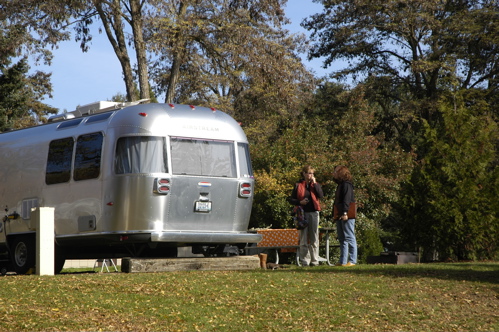
This morning was a good motivator to get moving. Our heat pump froze up around 4 a.m. This is the first time we’ve encountered this issue. When the temperature gets down into the 30s and there is high relative humidity, ice can form on the outside coils and prevent the heat pump from working. We’ve been having heavy dew each morning, but not until today did the magic combination occur that would cause the heat pump to stop producing heat. The cold air on my ears woke me up and I found it was 47 degrees inside the trailer. I flipped on the furnace and went back to bed, thinking it was time to head south and downward in elevation.
We said goodbye to the McDills, who are also heading south, and promised we’d all meet again on Tuesday in California. Partially because of our influence they are modifying their travel plans to include Yosemite. I think (after a holiday break) they’ll end up being on the road much longer than they originally thought. This lifestyle suits them well.
Because we had the wheels off the trailer (again), our drive down I-5 was periodically interrupted by my obsessive lug nut checks. Losing a wheel will do that to you. The road climbs up to the Siskiyou Pass (around 4,000 feet) where the weather can be dicey, and then descends slowly, first past Mount Shasta and the gorgeous Trinity area, then into the Sacramento Valley. Suddenly the temperatures soared to 80 degrees, the air smelled of growing plants, and we were back in summer.
Our goal today was the home of Doug and Sandy Keister in Chico. Doug is a photographer and author who has written several definitive books on travel trailers and motorhomes, and occasionally contributes an article or photo to Airstream Life. Sandy is a superior court judge. Doug and I been acquaintances for about three years, running into each other at Tin Can Tourist events and exchanging email, but have never had the chance to really sit down over dinner and get to know each other. So that’s what we did last night.
Doug and Sandy have a vintage “Safari” canned-ham type trailer that they hardly ever get to use. Being a prolific author (about 36 books so far), Doug is constantly traveling around the world and so he seems to live mostly on airplanes. At some point they plan to settle down more and travel in the trailer, but not any time soon.
Our stop here on the street in front of their house is necessarily short. It’s a quiet suburban cul-de-sac, but we aren’t really supposed to be here. We’ll move on in the morning and continue warming up in the glorious sun of the Sacramento Valley for a couple more days.
November 2, 2007 at 11:42 pm · Filed under Maintenance
The bleeding has stopped, momentarily. With Robert’s help I managed to finally bleed air out of the brakes to the point that they are responding much better than before.
As with all things, it was much easier once we had the proper tools and proper procedure. First thing this morning, Robert and I went to Grants Pass to fetch the correct sized wrench (1/4″) and then focused on the task itself. We had a few false starts and at times I was tempted to give up and call in the pros, but having moral support from Robert I soldiered on.
It turns out that the bleed valves on the front axle are virtually inaccessible without removing the front wheels, but once that is done (one at a time) the rest of the bleeding procedure is fairly simple. Of course the learning process involved some semi-humorous moments, including a time when I managed to get sprayed in the hair with brake fluid. (Note: brake fluid works a bit like hair gell.)
By about 11 a.m. we had it under control and had road-tested the trailer on the state park roads. Now that I know what to do, I plan to do the brake bleeding again in the next few days just for fun. No, not really. In fact, we need more brake fluid and a better place to work than in the state park, if we are to get the brakes back to the performance they originally had. We’ll be courtesy parking in the next few days, so I am hoping for a suitable spot to do the work.
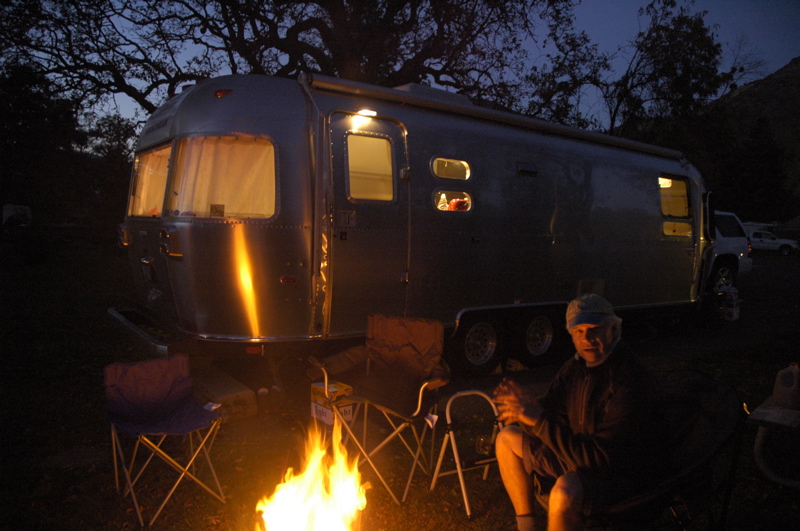
Emma and Allison have had a marvelous day, chasing each other around, playing all kinds of made-up games, eating blackberries off the bushes around the park, playing “spy” with the walkie-talkies, and generally being two very active little girls. We want to give them more time together, and do some hikes as a group, so we are hoping to rendezvous later this week.
The adults have done fairly well together too. We’ve discovered that Robert likes to cook breakfast, and one of his breakfasts lasts all day. The last time I had a breakfast like that was courtesy of my friend Rick at the Region 1 Rally in Woodstock. We didn’t need to eat again today until Robert made a fire (above) and started cooking up bratwurst (with bean soup, and corn bread).
It has been beautiful here at Valley of the Rogue. I could easily stay a few more days, but the clock is ticking against us if we want to get into Yosemite. Right now they are getting upper 60s and sunshine in Yosemite Valley, and the forecast for next week looks good too.
November 1, 2007 at 10:51 pm · Filed under Maintenance
The idea was to start heading south today but I decided to book another night here at Valley of the Rogue State Park, for three good reasons. First, our friends the McDills had decided to ditch the RV park that they were in, to come up and join us here. That meant more time for Emma and Allison to play, a big bonus, plus more time for the adults to plot future travels.
Second, this is a very nice state park and the late fall colors are beautiful. Third, I decided to attempt bleeding of the Airstream’s disc brakes.
Those of you long time readers probably know that I am not mechanically inclined. I’ve been forced by circumstance to learn travel trailer repair skills from time to time, so I can pretend to know what I’m doing for a few specific tasks. In the summer of 2006, for example, I learned how to replace lug studs on the wheels — because I had to.
Ever since our disc brake actuator was replaced in Warrenton, the braking action has not been as good as it was before. The conclusion by most of the people I’ve talked to is that a little air got in the brake lines. The solution is to bleed the brakes, a process of allowing some brake fluid to escape at “bleed valves” located on each brake. Once the brake fluid starts to come out free of air bubbles, the job is done. It sounds simple, but for me at least it has not been.
A simplified version of the instructions is this: activate the disc brake actuator so there’s pressure in the system, open the bleed valve on one of the brake calipers, let the fluid drain out through a clear vinyl tube into a jar of brake fluid, watch the bubbles, close the valve, add fluid to the actuator’s reservoir (so it doesn’t run dry) and move on to the next brake caliper.
The first task was to go into Grants Pass, six miles north, and get the necessary brake fluid and tubing. Then I attempted the job, with Eleanor working the brake controller to keep pressure on while I worked. It was a disaster. Instead of fluid running into the tube, it ran all over the place, leaving a big messy spot on the ground. I had the wrong size tube: 5/16″ inner diameter rather than 1/4″. I was also having trouble turning the nut, which I attributed to using an adjustable wrench rather than a box-end wrench.
So, off to the store again. This time I went to Medford, about 15 miles south, because there was a better selection of hardware stores. Back to the trailer. I tried again and again, but nothing helped. Still leaking all over the place, still having trouble with the nut. A few phone calls and several hours later, it emerged that I was turning the wrong nut. I was loosening the 7/16″ nut that holds the bleed valve in place instead of turning the very small 1/4″ nut that actually opens the valve.
Didn’t I say I wasn’t mechanically inclined? I didn’t even notice the little nut. I was beginning to feel like the big nut, however. By the time I noticed, it was too late in the day to make a third trip to the store, and after hours of wasted effort I was too frustrated to try again. Better wait until tomorrow. I can dream up a whole new batch of dumb mistakes to make, overnight.
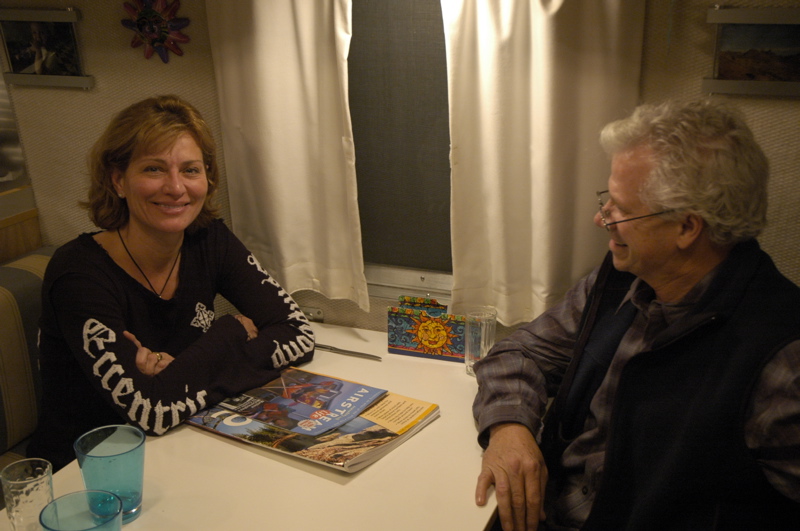
The McDills arrived in the campground around 5:30, by which time Eleanor was already deep into dinner prep: a ginger-teriyaki chicken stir fry; jasmine rice; Thai-sesame-lime shrimp on skewers; Asian green salad; fruit salad with mango, leechees, pineapple and Mandarin orange. Nobody had room for dessert.
We’ve made some plans to get to Yosemite before the season has gone too far. If all goes well with the brake bleeding we will depart on Friday, and if not we will hopefully depart Saturday. I want to get our brakes in top-notch condition before we do much more towing. We’ll meet the McDills next week sometime, in Yosemite.
October 31, 2007 at 11:56 pm · Filed under Uncategorized
A blue polar bear and a pirate girl went wandering down the streets of Ashland, OR today. Fortunately no one noticed because they were part of a large parade of oddly-dressed people.
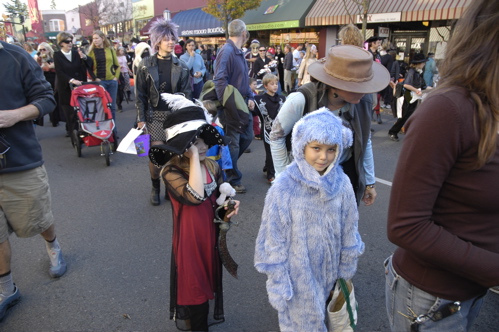
Ashland throws a huge costume parade down the main street for Halloween, and we were invited to attend by our new friends Kelli, Rob, and Allison. I say “new friends” because we’ve never met them before. Like us, they are traveling in an Airstream trailer with a young daughter and blogging the experience. Kelli and I have been reading each others blog for a few months, and Kelli realized recently that we would all be in Oregon right around Halloween, and invited us down so the girls could trick-or-treat together.
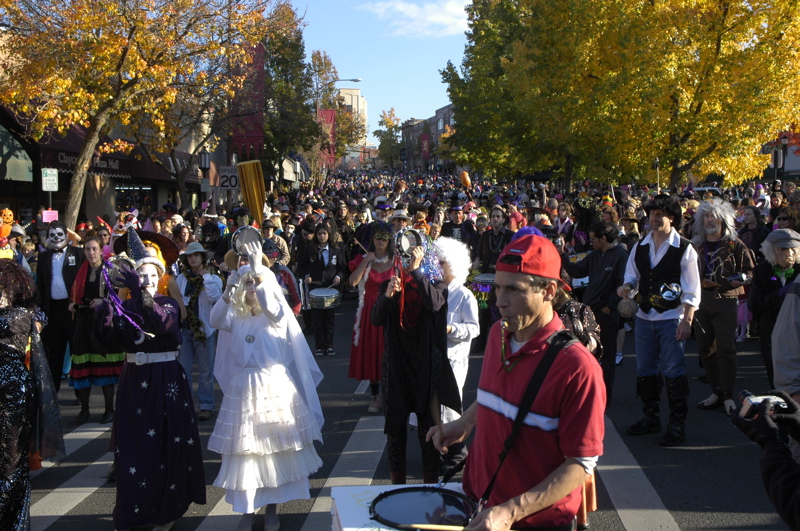
That turned out be a superb idea. Not only did Emma and Allison have a fabulous time together (parading, collecting candy, sharing their own private booth for pasta dinner after the parade, etc.) but the adults found a lot of common ground too. We’re thinking about getting together for some travels in California in the next couple of weeks.
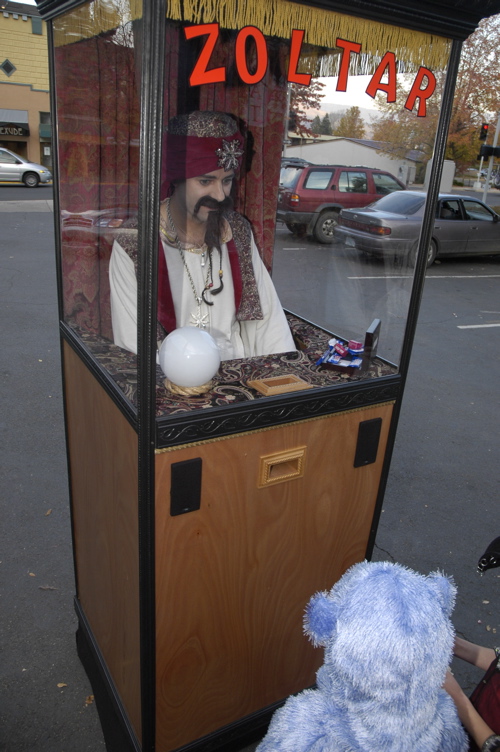 The Ashland parade was full of incredible and creative costumes, but the most amazing costume we saw today had to be Zoltar. This guy not only built the booth (full of intricate details) and the costume, but mounted the whole rig atop a Segway so it could travel along the sidewalks and streets.
The Ashland parade was full of incredible and creative costumes, but the most amazing costume we saw today had to be Zoltar. This guy not only built the booth (full of intricate details) and the costume, but mounted the whole rig atop a Segway so it could travel along the sidewalks and streets.
Without video it’s hard to convey how startling it is to see an entire booth, complete with mystical fortune-telling “robot” inside, roll up to you. It’s even more magical when strange music begins to play, and you hear Zoltar’s recorded voice announce in ethereal tones, “ZOLTAR SPEAKS!” Then he either tells your fortune or a joke, and the “robot” inside slowly picks up a candy and drops it in the bin so that you — the lucky recipient of a visit by Zoltar — can retrieve it.
And then, Zoltar silently glides away, booth and all.
It’s pure magic, and the guy who came up with it deserves some sort of award. Nicely done.
October 30, 2007 at 11:08 pm · Filed under Places to go
It turns out that just up the road from Eugene are the assembly facilities for both Monaco Coach (expensive motorhomes) and Marathon Coach (extremely expensive motorhomes). They’re right across the street from each other in Coburg, OR.
I like factory tours in general, and of course have a professional interest in travel vehicles, so the opportunity to see how these RV’s are built was impossible to pass up. (It doesn’t hurt that the tours are free.) Monaco runs the tours at 10 a.m. and 2 p.m. currently, and Marathon runs theirs at 11:30. The Monaco tour can run 1-2 hours (ours went almost a full two hours) so if you want to do both, go see Marathon first.
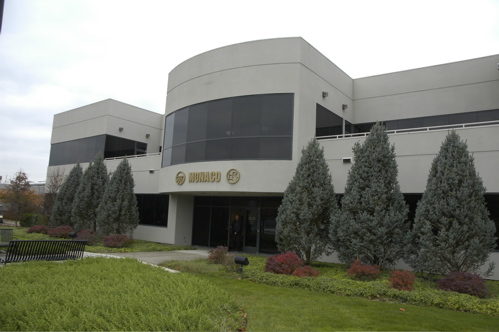
As is typical for these tours, cameras are not allowed, so I have no photos from inside the plant. But I can tell you it’s a great tour with lots of opportunities to get very close to all phases of the process. We watched as the motorhomes were welded together literally from the ground up starting with 3×8 box sections of steel for the frame rails. Monaco builds the whole coach including the chassis, whereas most manufacturers buy their chassis already pre-built, so you get to see just about everything that goes into making a motorhome.
Emma liked watching the process of heating and stretching vinyl to make dashboards, which looked like a giant art project that a kid could enjoy, but otherwise she wasn’t fascinated with the factory. But she was a good sport about it and we rewarded her with lunch at Subway, a kid favorite. I found everything interesting, and came out of the tour thinking what a well-built product Monaco made, which was precisely the point of the tour. Only two things hold me back from buying one right now:
1) Like most Class A motorhome manufacturers, they don’t make a two-bedroom floorplan.
2) I don’t have $500-800k to blow.
But otherwise, I was that close to writing a check on the spot. So I’d better not take the Marathon Coach tour. Those babies, built on Volvo bus chassis and highly customized, often run over a million bucks. I can’t even afford a tank of diesel in one of those…
We’ve moved on to our next stop, Valley of the Rogue State Park, between Grants Pass and Medford OR. We’ll spend Halloween here and take a couple of days to get other things done before heading into California.
« Previous entries ·
Next entries »












